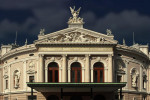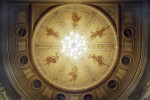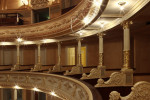History
It may seem that the institutionalised theatre, and Musical Theatre and Ballet in particular, have existed in Slovenia for a rather short period of time, especially when compared to other European milieus. However, if we take into account all the historical circumstances, we may untie ourselves of all the restraints and look back into our past with pride. The history of our stage has been varied and very much alive, especially because many years passed before it was really taken over by the Slovenian artists and creators, who mostly became members of our permanent ensembles. And, more than 90 years have passed, since the times, when the Ljubljana Ballet Ensemble made its first steps towards professionalism and was soon followed by the Orchestra of our Opera Theatre.
Let us skim through some important events that marked these past decades. When the Slovenian Regional Theatre obtained its new building (today’s Opera Theatre) in 1892, both Slovene and German theatre and opera performances were staged in it. In this theatre the Slovenian Opera was finally able to engage its permanent conductors, soloists and choir. The performances were first accompanied by hired military musicians and from 1908 on by the members of the newly founded Slovenian Philharmonics. In 1911, the performances of the German ensemble were moved to a new building (today’s Drama Theatre). During World War I, the muses in the Ljubljana Opera fell silent and the theatre building became home to the Cinema Central until – in the spring of 1918 – the theatre consortium decided to finally realise its goal and reopen the Slovenian stage for the 1918/1919 season. Thus, the Slovenian music and theatre scene was revived during the autumn of the same year, even so that the theatre and opera performances could be complemented by the ballet spectacles as well.
At that time, our opera programme was mostly marked by the best French and Italian repertoire, however, a substantial emphasis was also given to some Slav and especially Slovenian operatic works. In the period between the two world wars, the Opera Theatre modernised its repertoire and several successful operas by the Slovenian composers Kogoj, Osterc and Bravničar were staged as well. After World War II the Ljubljana Opera Ensemble gained esteem and respect abroad as well. The opera The Love for Three Oranges became a tremendous success during its international tour in the Netherlands, and particularly its triumphant performance at the Paris Opera. In 1957, the recording of Sergei Prokofiev’s opera The Love for Three Oranges under the baton of the renowned Slovenian conductor Bogo Leskovic, was awarded the Phillips Grand Prix as the world’s Best Recording of the Year.
In the beginning of the 1918/19 season the first performances of the opera and operetta productions with the participation of the Slovenian Ballet Ensemble, led by its own Artistic Director, were put on the stage, and in the spring of 1919 the first independent ballet – The Abduction of Evelyne – was finally premiered too. In the Ballet’s very first professional years, a number of famous classical pieces were already performed however its repertoire also contained some modern Slovenian works. To this day the audience in Ljubljana has been able to attend to many different productions from classical ballet repertoire, and also to quite a number of new dance creations, staged by both Slovenian and foreign choreographers.
Today – apart from some regular programme novelties, offered to its audience every season – the central Slovenian Musical Theatre boasts a wide repertoire of operas, ballets and concerts that derive from both modern and classical creativity, as well as around 150 season and off-season repeat performances on stages at home and abroad. The Slovenian National Theatre Opera and Ballet Ljubljana has been successfully staging its own productions as well as cooperating with various international and Slovenian co-producers for several years, and thus producing an enviable number of acclaimed projects (Faust, Aida, The Love for Three Oranges, Don Quixote, Prince Igor, etc.). Certainly, one of the most memorable performances was the world premiere of the Offenbach’s newly discovered The Rhine Nymphs.





